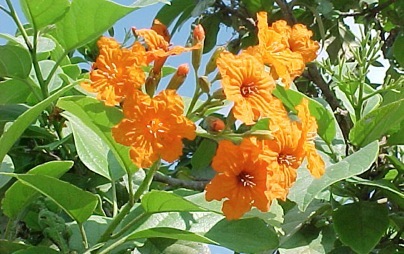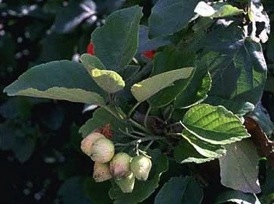Cordia sebestena: Foraging Geiger Counter
Foragers eat the mild fruit of the Geiger Tree and care not about the particulars. Botanists care about particulars and can’t agree where it came from but they are pretty sure it is not a Floridian but in Florida it was named.
The Geiger Tree got it’s name from no less a person than John James Audubon. But, before I explain that, the record should be set straight about Jean-Jacques Fougère Audubon.
He was born a French citizen in Haiti, went back to France as a boy then to the US at age 18 to avoid being drafted into the French army by Napoleon. He learned English from Quakers and used “thee’s” and “thou’s” long since passe even then. That he was a bigger than life personality and an innovative artist is quite true and worthy of mention. His drawings did promote interest in nature. But you should know that the National Audubon Society is far more nobel than the man whose name they perpetuate.
The society not only had no substantial connection to Audubon but is an advocate of nature. Audubon raped nature. He kill scores, many times hundreds of just about every creature he ever drew. And that is not an exaggeration. He was not a protector of nature by any definition. A bad day was a day he did not shoot several hundred birds. He was a one-man extinction machine. Even by the standards of his day he was an excessive hunter when he did not have to be. Conservation was not in his vocabulary. As an old man he changed his mind but I am not sure that has any value. It did not bring back the tens of thousands of the creatures he dispatched. Food is one thing, wholesale saughter is another. Since he was famous for his painting of birds it was a good marketing strategy for the nature group to call themselves the National Audubon Society. The irony is that the society is all about being good to nature while Audubon himself was all about being bad.
As for the Geiger Tree… John H. Geiger was a sea captain, harbor master, salvager and pirate based in Key West, which at the time was the richest city in America. He made a lot of money legitimately and illegitimately and had a mansion there, though then the key was called Thompson Island. Audubon saw the Geiger House in 1832 while (hunting of course) and sketching 18 bird pictures. Geiger had reportedly planted two Cordia sebestena on the property — it is the prettiest of the genus. (I doubt a swashbuckling pirate would plant a pretty tree so maybe Mrs. Geiger deserves the credit. ) Audubon used one of them in a drawing prompting the tree to be called the Geiger Tree. Audubon wrote:
“The Rough-leaved Cordia
This plant, on account of its large tubular scarlet flowers, is one of the most beautiful of the West Indian trees. I saw only two individuals at Key west, where we supposed, they had been introduced from Cuba. They were about fifteen feet high, the stem having a diameter of only five or six inches. They were in full bloom in the early part of May, and their broad deep green leaves, and splendid red blossoms, mingled with the variety of plants around me, rendered their appearance delightful. Both trees were on private property, and grew in a yard opposite to that of Dr. Strobel, through whose influence I procured a large bough, from which the drawing was made, with assistance of Mr. Lehman. I was informed that they continue to flower nearly the whole summer.”
Audubon, by the way, did not stay at the now “Audubon House” while in Key West. He slept aboard the revenue cutter Marion. The Marion and crew escorted Audubon and entourage plus his dog Plato around the keys and Dry Tortugas for six weeks in April and May 1832. They were the coast guard of their day and saw much action.
The Cordia sebestena (KOR-dee-uh seb-ess-TAY-nuh) has been planted through much of the warm world for its scarlet flowers and edible white drupes. While the fruits are edible their smell is better than they taste. Cooking improves their flavor some. They are also fibrous. The tree also has a long medicinal history. Where it is from is a debate, from Cuba to the West Indies to South America. The teapot tempest rages on. The fruit of the C. alliodora is also edible.
Cordia (which means late) was named for father and son German botanists/pharmacists/physicians Euricius Cordus (1486-1535) and Valarius Cordus (1515-1544.) Euricius (Heinrich in German) was a professor and the 13th son of a farmer named Urban Solden. As number 13 little Heinrich was called the “late one” or in Latin Cordu. He kept the name as a last name when he Latinized his name as many educated people of that age did, going from Heinrich Urban Solden to Euricius Codus. His son, Valarius Codus, died at 29 of malaria while in Rome but had already established himself as an intellectual heavyweight of his age. His posthumous publications bolstered his reputation even more. Sebestena is from Sebesten, a name given to a related tree with similar fruit.
Green Deane’s “Itemized” Plant Profile
IDENTIFICATION: A small tree, usually under 25 feet, upright slender branches, leaves drop in cold or dry periods. They are alternate, ovate, pointed , sometimes slightly toothed near tip, five inches to a food long, three inches to half a foot wide, dull, rough hairy above, and pale and nearly smooth below, in clusters at the ends of branches. Flowers scarlet or orange, funnel shaped, five to seven lobes, slightly crinkled, one to two inches wide, showy flat terminal clusters. The calyx (fruit) is conical or pear-shaped one to one and a half inches long, white, pleasantly fragrant, with one or two large dark brown seeds.
TIME OF YEAR: Spring to late fall
ENVIRONMENT: Hammocks, sand dunes, landscaping
METHOD OF PREPARATION: Fruit is juicy and edible raw (not the seeds.) Cooking improves the flavor.




